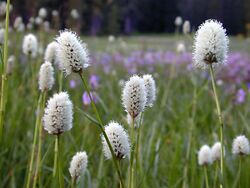Biology:Bistorta bistortoides
| Bistorta bistortoides | |
|---|---|

| |
| Scientific classification | |
| Kingdom: | Plantae |
| Clade: | Tracheophytes |
| Clade: | Angiosperms |
| Clade: | Eudicots |
| Order: | Caryophyllales |
| Family: | Polygonaceae |
| Genus: | Bistorta |
| Species: | B. bistortoides
|
| Binomial name | |
| Bistorta bistortoides | |
| Synonyms[1] | |
| |
Bistorta bistortoides (American bistort, western bistort, smokeweed, mountain meadow knotweed, mountain buckwheat or mountain meadow buckwheat) is a perennial herb in the buckwheat and knotweed family Polygonaceae.
Description
Bistorta bistortoides plants generally grow to 10–51 centimetres (4–20 inches) tall.[2] Individuals growing above 2,250 metres (7,380 feet) are smaller, seldom reaching more than 30 cm (12 in) in height.
The leaves are leathery and 2.5–10 cm (1–4 in) long,[2] being mostly basal on the stem. The dense cylindrical to oblong inflorescence is 2.5–5 cm (1–2 in) long and packed with small white to pinkish flowers, each a few millimeters wide and with protruding stamens.[3]
Taxonomy
The species name remains unresolved.[1]
Distribution and habitat
B. bistortoides is distributed throughout the Mountain West in North America from Alaska and British Columbia south into California and east into the Rocky Mountains.[4][5]
The plant grows from foothills to above the timberline.
Ecology
Rodents and bears consume the roots, and elk and deer browse the foliage.[2]
Uses
American bistort was an important food plant used by Native Americans living in the Mountain West, including Blackfoot and Cheyenne peoples.[2] The roots are edible either raw or fire-roasted[6] with a flavor resembling chestnuts. The seeds can be dried and ground into flour and used to make bread. They were also roasted and eaten as a cracked grain.[7][8] The young leaves can be eaten raw or cooked.[2]
References
- ↑ Jump up to: 1.0 1.1 "The Plant List: Bistorta bistortoides (Pursh) Small". Royal Botanic Gardens, Kew and Missouri Botanic Garden. 2013. http://www.theplantlist.org/tpl1.1/record/kew-2676772.
- ↑ Jump up to: 2.0 2.1 2.2 2.3 2.4 Benoliel, Doug (2011). Northwest Foraging: The Classic Guide to Edible Plants of the Pacific Northwest (Rev. and updated ed.). Seattle, WA: Skipstone. pp. 37. ISBN 978-1-59485-366-1. OCLC 668195076. https://www.worldcat.org/oclc/668195076.
- ↑ Flora of North America, Bistorta bistortoides (Pursh) Small, 1906. Western or American bistort , smokeweed
- ↑ Biota of North America Program 2014 county distribution map
- ↑ Turner Photographics, Polygonum bistortoides – Wildflowers of the Pacific Northwest photos, description, partial distribution map
- ↑ Fagan, Damian (2019). Wildflowers of Oregon: A Field Guide to Over 400 Wildflowers, Trees, and Shrubs of the Coast, Cascades, and High Desert. Guilford, CT: FalconGuides. pp. 71. ISBN 1-4930-3633-5. OCLC 1073035766. https://www.worldcat.org/oclc/1073035766.
- ↑ Edibility: Identification and edible parts of American Bistort
- ↑ Tilford, G. L. Edible and Medicinal Plants of the West ISBN:0-87842-359-1
External links
- Jepson Manual Treatment – Polygonum bistortoides
- United States Department of Agriculture Plants Profile
- Polygonum bistortoides – Callphotos Photo gallery, University of California
Wikidata ☰ Q18079229 entry
 |

